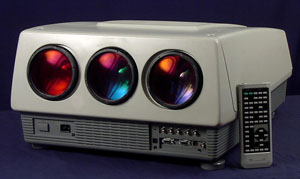 |
 NEC PG Series NEC PG Series
Mechanical Setup Procedure
|
(Page 5)
|
Page: 1 2
3 4 5 6
7 8 |
RASTER CENTERING
Make sure the lenses are off the projector for these steps. Now turn the
contrast to 0 and the
brightness to 100. You should see a clearly visible raster with the actual image
within that area.
NOTE: If you CANNOT see the raster at this setting, you will have to go into the
KELVIN menu
first. Turn up the “B” for background slider up until the raster for each color
becomes CLEARLY
visible. Store this value. Now continue.
NEVER, NEVER, NEVER turn the G2 pots on an NEC
unless
you absolutely KNOW how to adjust this projector. The same applies for all the
other pots on any
board unless you are specifically told to do so, and how. If you do... you will
need to hire someone
like Curt, Doug, or myself to undo the Damage. I need the work.
Thank you. :)
We will concentrate on the green tube first, as this is the “Reference” for
everything else. With the
electronic position menu set to “0” and stored, the raster should be in the
exact center of the green
tube. I'd bet it's not, though. All right, first off the raster should not be
too wide. It should not be
closer than half an inch to the left and right tube edges. To move the raster,
you need to turn the 2
tabs of the centering magnets until the raster is centered in the tube face. Use
only ONE hand in the
projector at any time, and do NOT lean on the frame with the other hand to
steady yourself. This is
for your safety, in case you get zapped. You NEVER want to create a path through
your heart with
both hands.
The adjustments are delicate and require finger feel so don't use anything other
than your fingers to
push the magnets around with.
You may want to use the KEYSTONE menu to make the raster into a rectangle for
easier
measuring. Work at it to get the raster nicely centered, use a ruler if
possible. You can use the
GREEN AMPLITUDE setting to increase the raster until it is within a half inch
(12mm) of the tube
edges, no more than a quarter inch (6mm)! Yes, everyone wants to maximize the
raster to use as
much of the tube as possible, but the NEC is not designed for this. If you use
too much, the
electronics run hot, and will be unstable and even fail. You are warned.
Once the raster is centered in the green tube, move on to the red and blue tube
and repeat the
procedure. You should be met with 3 nicely centered rasters once done. Sounds
easy? Not so fast.
IMAGE CENTERING
Ok, you can see that the raster itself is the scanning matrix that the actual
IMAGE is contained in.
Note that the IMAGE is actually SMALLER than the raster. This is normal, and we
will deal with
this next. Now use the POSITION menu to shift the image left and right until you
center the
IMAGE inside the RASTER. The image may get brighter and/or darker while doing
this. This is
normal. Once the image is centered, store the setting. Now go to the BLANKING
menu and adjust
the left and right blanking until the blanked area almost touches the IMAGE. You
will notice that
the image probably gets brighter again, this is normal.
You should see a tiny gap between the image and the blanked out raster visible
as a lighter area.
You don't want to blank out any of the actual image, just almost touch it. Run
the blanking back and
forth to see the effect. Don't worry about the top and bottom at this point.
NOTE: If you need to
resize your video image later on to fit your screen size don't forget to first
back out the blanking so
you see the entire video image.
TEST PATTERN CENTERING
Now you should have a centered raster, and a centered image within that raster.
The next step is to
properly phase the internal test signals with that image. To do this, put up the
PHASE menu. Adjust
the CURSOR PHASE until the VERTICAL bar of the crosshair is dead center in the
raster. Store
that setting. On some projectors when you enter the PHASE menu you will see a
grid test pattern
instead of the crosshair pattern. In this instance you will move the “C” slider
adjustment until the
center of the grid is moved to the center of the video and raster image. At this
point you should
have a properly centered raster, image, and crosshair. If anything is off, go
back and fine tune as
needed.
It is now time to put all the lenses back on. You did dust them off first,
right? You can also readjust
the brightness, contrast and the B Kelvin back to normal levels so that you can
see the video image
better for the following steps.

|
|


 NEC PG Series
NEC PG Series